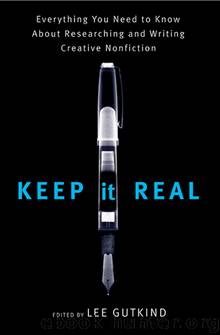Keep It Real by Lee Gutkind

Author:Lee Gutkind
Language: eng
Format: epub
Publisher: W. W. Norton & Company
Published: 2013-05-02T16:00:00+00:00
Keeping It Brief
“Anybody can have ideas—the difficulty is to express them without squandering a quire of paper on an idea that ought to be reduced to one glittering paragraph.” That’s Mark Twain, arguing against verbosity.
Twain would likely have been a fan of the nonfiction short.
Taking a page from the popularity of sudden fiction, editors Judith Kitchen and Mary Paumier Jones put brief nonfiction on the literary map with their 1996 anthology In Short. In their introduction, Kitchen and Jones attribute the trend toward brevity in part to writers and readers “schooled by the quick takes of television and the movies” translating a rapid grasp of scene and context to the written word.
In an introduction to the collection (so popular it was followed by a second, In Brief, and a third, Short Takes), Bernard Cooper, author of Maps to Anywhere, suggests that short nonfiction “requires an alertness to detail, a quickening of the senses, a focusing of the literary lens, so to speak, until one has magnified some small aspect of what it means to be human.”
Cooper is among the contemporary essayists who focus on brief nonfiction. Others include Eduardo Galeano, Stuart Dybek, Brian Doyle, and Abigail Thomas, author of Safekeeping, an engaging memoir made up of one- and two-page chapters, some as brief as one hundred words. The very concise form seems to attract a fair share of poets, and in fact, the border between sudden nonfiction and the prose poem remains murky and under dispute.
Kitchen and Jones, in their three anthologies, define “brief” as “2,000 words or less,” a challenge to many writers accustomed to a wider canvas, but the online journal Brevity takes an even stingier approach, limiting writers to 750 words.
Brevity editor Dinty W. Moore asks his writers for sharp description and careful distillation. “I like to imagine a brush fire, deep inside a national park,” he explains. “The reader is a firefighter, and the writer’s job is to parachute that reader directly to the edge of the blaze to encounter flame and smoke immediately. There is no time for the long hike in.”
Download
This site does not store any files on its server. We only index and link to content provided by other sites. Please contact the content providers to delete copyright contents if any and email us, we'll remove relevant links or contents immediately.
Asking the Right Questions: A Guide to Critical Thinking by M. Neil Browne & Stuart M. Keeley(5635)
Autoboyography by Christina Lauren(5183)
Eat That Frog! by Brian Tracy(4435)
Dialogue by Robert McKee(4321)
Sticky Fingers by Joe Hagan(4101)
Journeys Out of the Body by Robert Monroe(3571)
Annapurna by Maurice Herzog(3423)
Full Circle by Michael Palin(3387)
Schaum's Quick Guide to Writing Great Short Stories by Margaret Lucke(3319)
Elements of Style 2017 by Richard De A'Morelli(3307)
The Art of Dramatic Writing: Its Basis in the Creative Interpretation of Human Motives by Egri Lajos(3015)
Atlas Obscura by Joshua Foer(2898)
The Diviners by Libba Bray(2887)
In Patagonia by Bruce Chatwin(2875)
Why I Write by George Orwell(2874)
The Fight by Norman Mailer(2848)
The Mental Game of Writing: How to Overcome Obstacles, Stay Creative and Productive, and Free Your Mind for Success by James Scott Bell(2845)
Venice by Jan Morris(2526)
The Elements of Style by William Strunk and E. B. White(2440)
